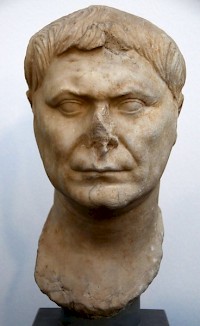Pliny the Younger (5)
Pliny the Younger or Gaius Plinius Caecilius Secundus (62-c.115): Roman senator, nephew of Pliny the Elder, governor of Bithynia-Pontus (109-111), author of a famous collection of letters.

An epitaph found near Como states that the deceased is sad, because after her death, nobody will remember the caring people only she remembered. The sentiment would have appealed to Pliny, who knew that he was going to be forgotten. His wife had died and he had no children - who would remember him? (It is tempting to make a connection between the death of his second wife and his proceeding against Publicius "to make himself known".)
Pliny used the years after his consulate to do something that would make sure that he would be remembered. He published his pleadings, a long eulogy on the reign of Trajan (the Panegyricus), and a collection of poetry. He could take all the time he needed, because after the death of Domitian, there was no shortage of candidates for the more important functions in the Roman government. And perhaps Pliny, who had been in office continuously for nine years, simply wanted to live a bit more quietly.
In 103, he published three books, containing (a part of) his correspondence. To a certain extent, the letters are comparable to the building erected by rich Romans: useful, and intended to be remembered.
In Antiquity, letters were even more important than today. The success of a career was to a large extent dependent upon invitations and recommendations. And a man could show in his correspondence that he was well-educated, which was absolutely imperative for anyone dreaming of a career.
Pliny's letters can be regarded as a collection of models, and has indeed been used for educational purposes well into the eighteenth century. For example, he offers a few ways to begin a letter, but he also shows how this model can be varied upon. Sometimes, he explicitly offers advice - ironically. In Letter 2.20 he states that a letter has to have one single theme, which has to be illustrated with three examples: in this case, three malicious anecdotes about Marcus Aquilius Regulus, a personal enemy of Pliny.
Of course, a collection like this had to contain examples for all possible occasions. There had to be a model letter to inquire about someone's activities, there had to be a charming invitation for a nice dinner, and there had to be a letter that forced the addressee to send a charming invitation for a nice dinner. Pliny gave examples of all possible letters.
This does not mean that the letters are invented, although Pliny polished them before publication. Their authenticity is all the more intriguing because the addressees are sometimes extremely important persons: for example, Trajan's chief of staff Lucius Licinius Sura and his attorney general Lucius Neratius Priscus. We also meet the biographer Gaius Suetonius Tranquillus, who is asked for help when Pliny learns that he recites his poetry badly. The historian Cornelius Tacitus, a personal friend of Pliny, receives letters about the eruption of the Vesuvius, which Pliny has witnessed.
Reading the letters, we get the impression that Pliny was an amicable man, good at heart. For example, he tells how he sent one of his freedmen, who suffered from tuberculosis, on a cruise to Egypt; and when the dry air of the desert did not cure the patient, he sent him to a chalet in the Alps.note A real philanthropist, we might think, although the fact that he personally published his letters, makes one change one's mind. He wanted us to think about him as a philanthropist.

There is something insincere about the man. He could be friendly and kind to anyone, but it seems that his amicability was some sort of façade, a mask. This comes as no surprise. Pliny had been able to survive Domitian's tyranny and must have developed a functional dishonesty. It was a survival strategy, and not a bad one. As we will see below, insincerity was his management tool when he was governor of Bithynia-Pontus.
Pliny's correspondence became popular, and after the first three books, he published six additonal volumes. He was pleased when Tacitus told him that he had been visiting the horse races and had been mistaken for "that famous author Pliny". Of course, the author of the Letters was flattered, but he was also proud to be mentioned in one and the same breath with his friend.
In these years the successful author married again. Calpurnia was the love of his life. Of course he was forty and she fourteen, but this difference was no obstacle to a happy marriage. Pliny published several love letters, which are very interesting - not because of their contents, but because they are there: his was one of the first letters like these.